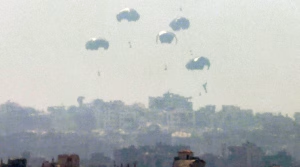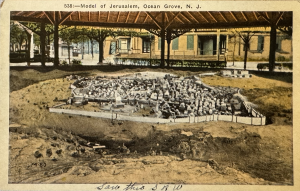A long row of footprints made from sand-cast glass and cement, wiped over with black paint and earth, leads from the main area at the Canadian Clay and Glass Gallery in Waterloo, Ont. into a dark, cave-like room. The black footprints walk toward a circle of shiny, silver glass footprints piled on top of each other.
The feet represent the death marches from Auschwitz to Birkenau. Since the cavernous room recalls a kiln or oven, the effect is haunting. The shiny footprints are a tribute to members of artist Laura Donefer’s father’s family who the Nazis murdered during the Holocaust.
“I wanted to honour all of the victims, but at the same time I wanted it to end on a note of hope,” says Laura Donefer, an artist from Harrowsmith, Ont. “I was thinking of the circle of life and the pathway to resurrection and hope.”
The installation is part of a new exhibit at the gallery, entitled WAR: Light Within/After the Darkness. It is Waterloo’s first art exhibit devoted to the Holocaust.
The art pieces deal with resistance, survival and the potential for hope in cataclysmic circumstances.
“You must have hope in order to resist, and then you can see and create beauty if you have hope,” says gallery curator Christian Bernard Singer. “The idea of hope is really integral to being able to get through anything. It’s the idea of someone not forgetting their own humanity.”
The exhibit was inspired from Singer’s grandmother, who told him stories about when her mother would receive letters from Jews in Europe begging to come over to Canada during the 1930s.
“After the war, the letters stopped coming and everybody found out what really happened. My great-grandmother was wracked with guilt about that… and that guilt transferred to my grandmother,” Singer says. “She would tell the story about it and she would cry. It had a real impact on me.”
Another section of the gallery features works from their permanent collection by Jewish and gay artists. The Nazis would have considered these works to be degenerate.
Several of the featured artists in this exhibit have a connection to the Holocaust or were inspired by stories from the war.
Toronto artist Mary McKenzie’s piece, called Departed, features a living room with half of the surface destroyed and turned to ash. Some of the details from this space were inspired by the home of her husband’s family, who lived in a Dutch village during the war.
The setting recalls what homes that were bombed looked like after an attack, frozen in a moment in time. In Departed, the living room has a sofa, carpet and piles of folded laundry. To create these ghosts of the past, McKenzie dipped the articles of clothing into clay and fired them so that the item burned but a clay molding remained.
“What I wanted to convey by the laundry was that it was not just a room. It was a room that was lived in,” McKenzie says. “When we see laundry, the details of you as a person are embedded in that. That becomes very intimate and very universal.”
Meanwhile, in a memorial from Ottawa husband and wife artists Oded and Pamela Ravek pay tribute to the six million Jews murdered, as well as to Oded’s mother and her two sisters who survived Auschwitz.
“It’s a miracle that she survived,” Oded explains. “She actually told me not long ago that every night before she goes to sleep, she sees the camp. It never leaves her. Her mother was taken to the gas chamber in the last few days before [the Jews] were liberated.”
Oded and his son had his mother’s number emblazoned on their arms as a sign of remembrance.
In another installation, Hanging Forest, from Toronto artist Chari Cohen, suspended porcelain trees dangle over a cracked earth surface on the ground. The hope lies in the grass that spikes up from the bottom of the platform.
The grass has been planted there and will grow right into the trees as the exhibit continues. WAR: Light Within/After the Darkness will run in Waterloo until March 16.






